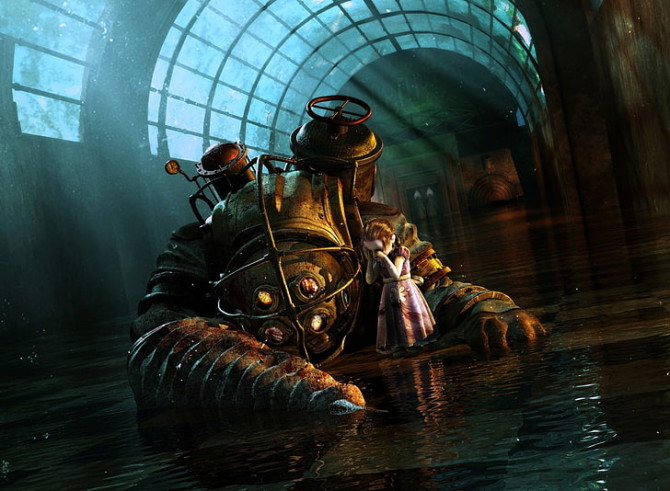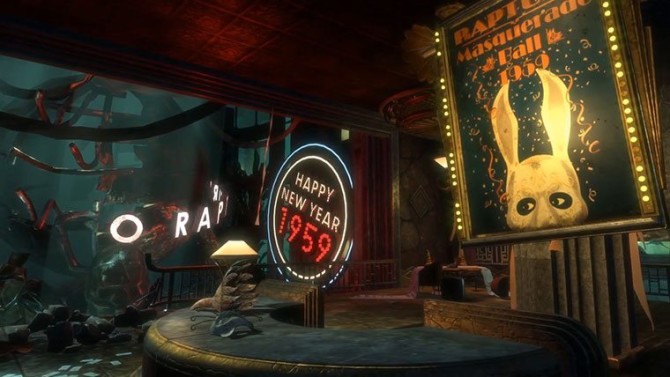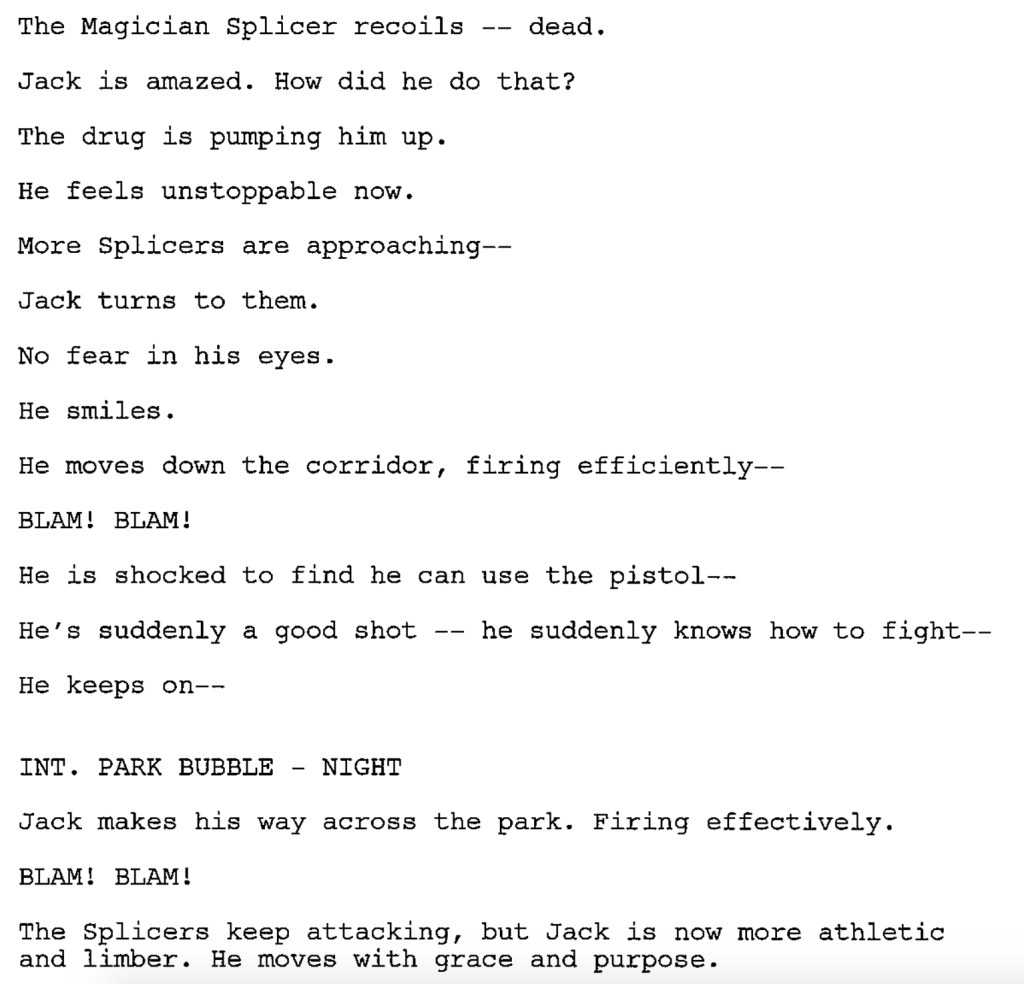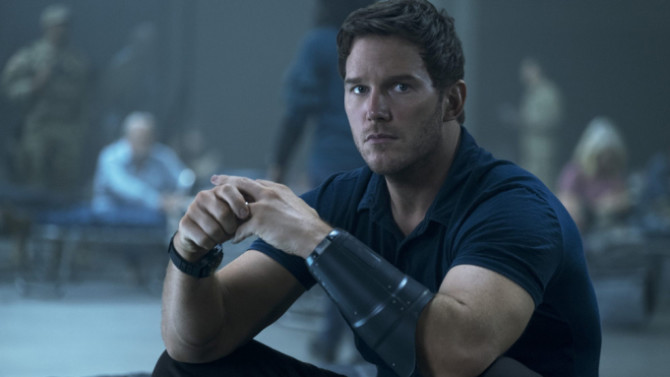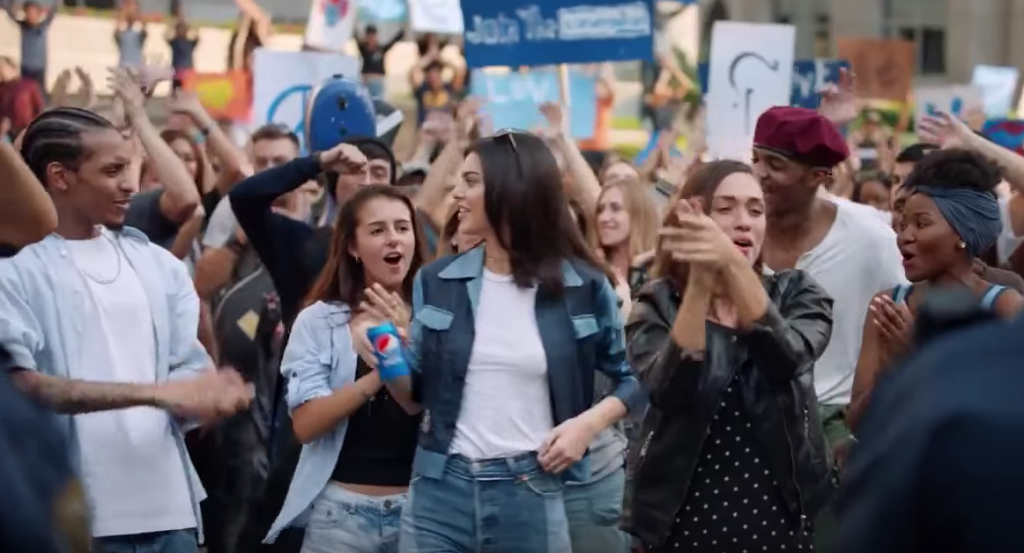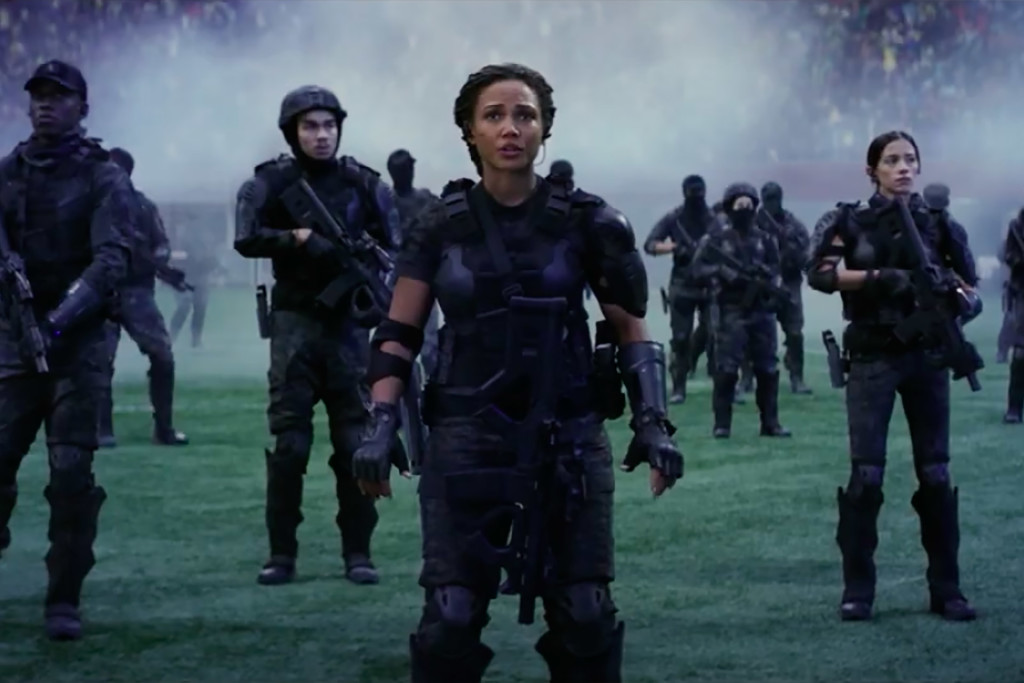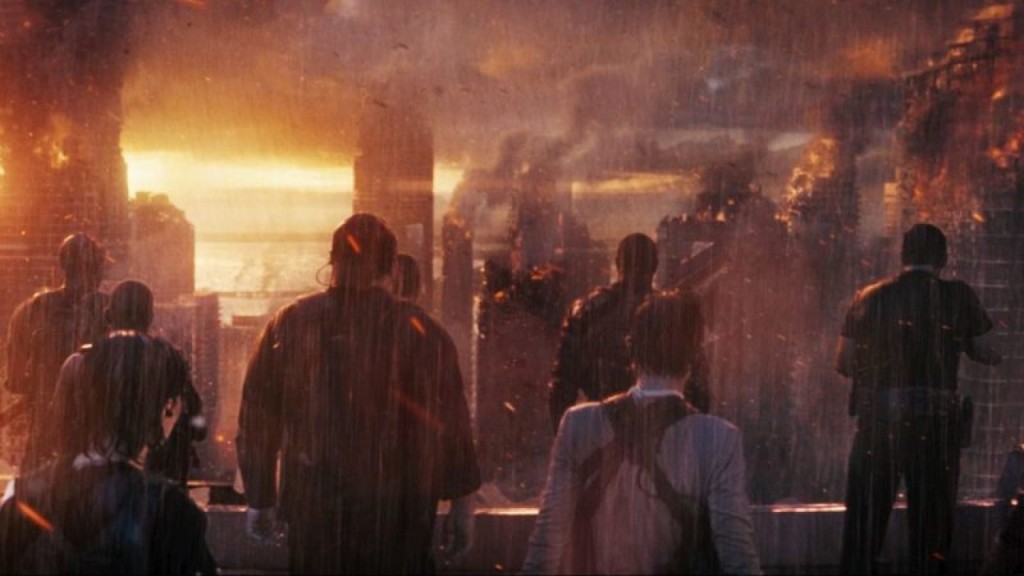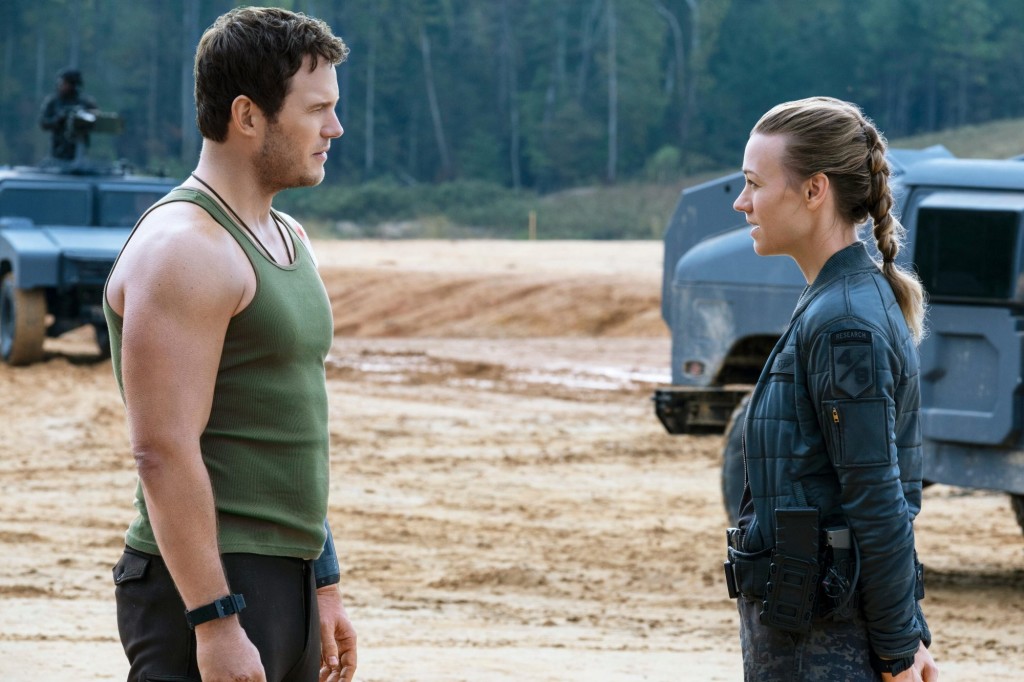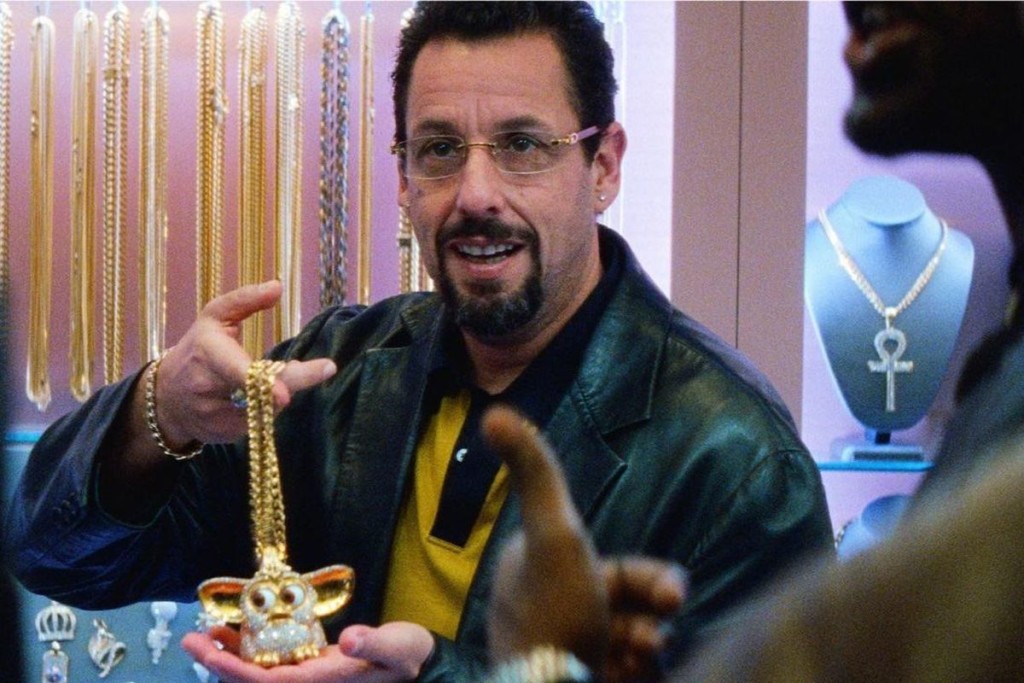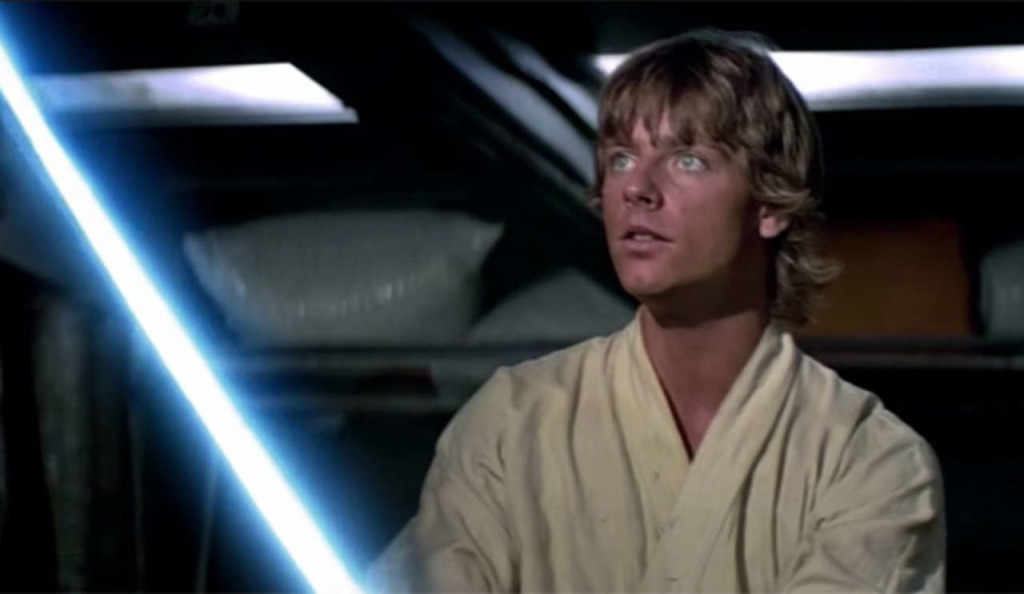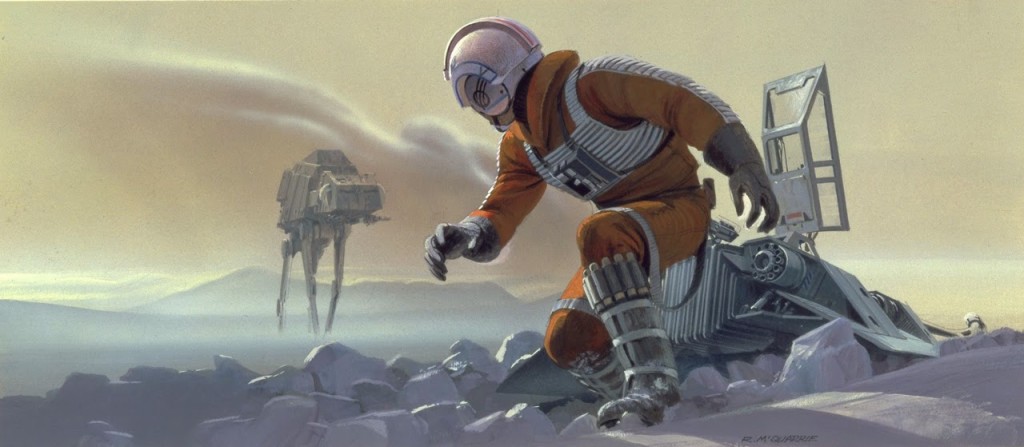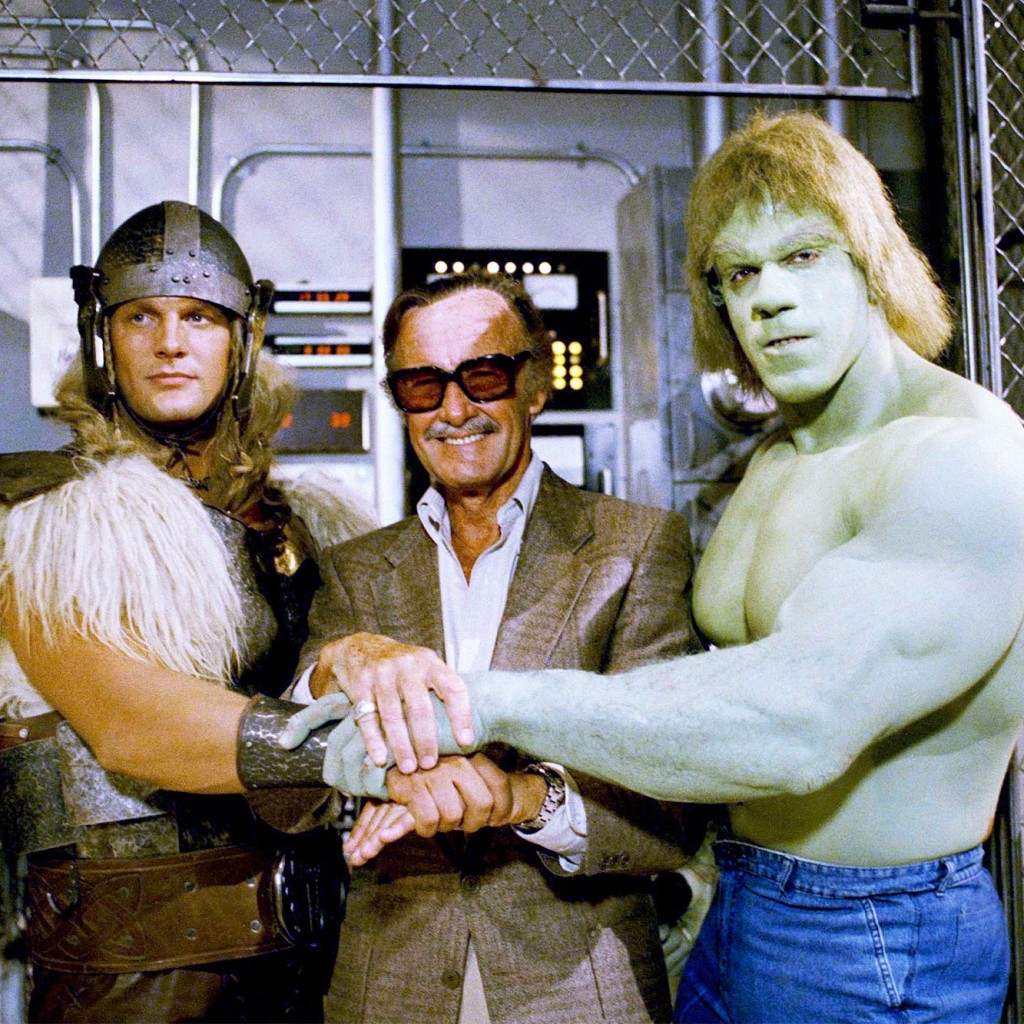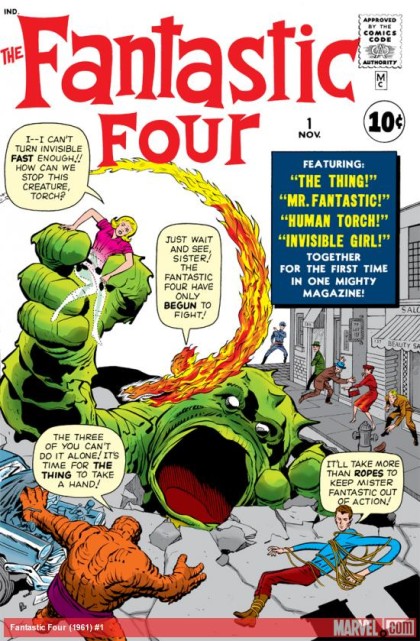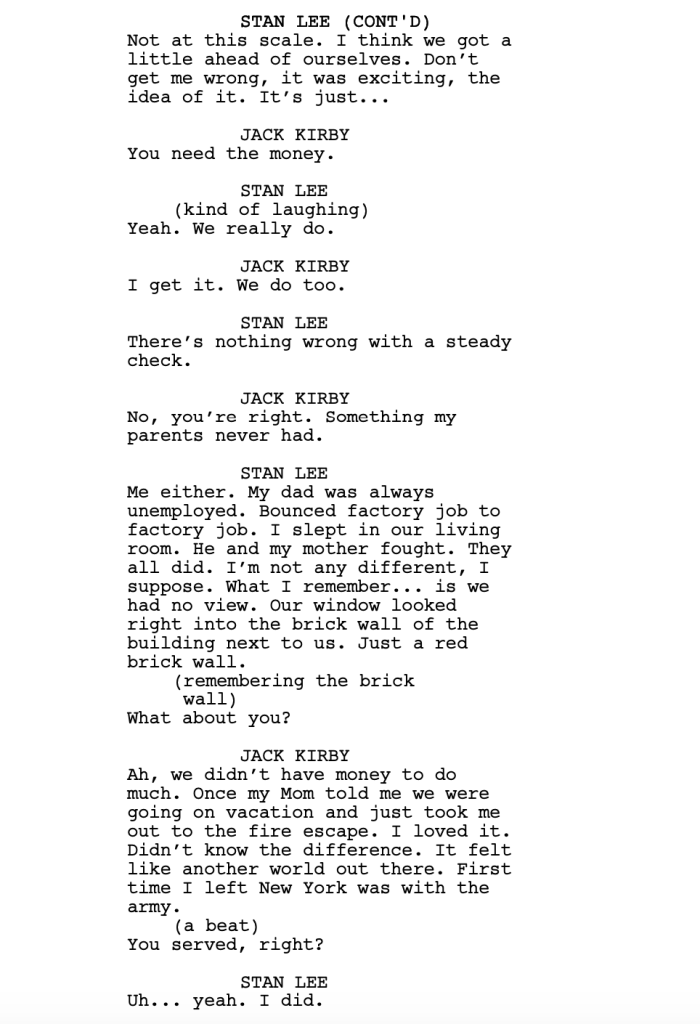Search Results for: the wall
Genre: Sci-Fi/Horror
Premise: After his plane crashes, a man finds himself stuck in a giant deserted 1950s city at the bottom of the ocean.
About: Bioshock was heading towards production a decade ago when, just weeks before shooting started, it was cancelled. But according to lore, it was not cancelled because they couldn’t get the script right. It was cancelled because the studio got nervous about a 200 million dollar R-rated film, particularly when there had been so many high profile video game adaptation failures recently. For all intents and purposes, the script might have been great. You think that with content hungry streamers desperate to find the next big thing, Bioshock is going to find a home at some point, likely as a series.
Writer: John Logan (Gore Verbinski was set to direct)
Details: 111 pages
I’m trying to inspire you guys with some A-grade sci-fi world-building here.
John Logan is a fascinating screenwriter. He’s credited with over a dozen high profile studio movies (Skyfall, Alien: Covenant, Hugo, Sweeney Todd, The Aviator, The Last Samurai, Star Trek: Nemesis, The Time Machine, etc.). Yet he doesn’t have a single movie that you actually remember and want to revisit (with the exception of, maybe, Gladiator). In many ways, he’s the ultimate studio screenwriter. And what I’m going to try and do today is figure out what John Logan does to be so perfectly suited to write big budget studio movies.
Let’s take a look.
The opening to Bioshock is basically the opening to The Graduate. So much so that they might be able to save money just by buying the dailies to the Mike Nichols film. It’s 1960. A guy name Jack just graduated college. His rich father wants him to join the firm. We see his graduation party with all his dad’s friends, many of them obsessed with their golf swings. His father takes him to work the next day, shows him his pathetic little office, and Jack has a mental breakdown. There is no way this is going to be his life.
Cut to Jack on a Pan Am flight to Barcelona. Jack doesn’t have a game plan once he lands in Barcelona. He just knows that he wants to get as far away from Mrs. Robinson as possible. Luckily, he won’t have to figure it out because his plane crashes Castaway style. Jack survives and swims to a lighthouse. But, once inside, he finds himself being shot down into the ocean via an elevator and arriving in a giant underwater city from the 1950s.
The place is dilapidated with debris and puddles everywhere. After watching a monster creature slice a young mother apart, Jack runs into an Irish guy named Atlas who’s one of the last people in the city not to have turned into a crazed monster. He tells Jack there’s a sub on the other side of the city. That’s the only way out of here. And so off they go, across this monster-infested cesspool, to try and get out.
Along the way, Jack sees a lot of curious things. For example, when he stumbles into a “Leave it to Beaver” household, he sees a picture of his dog from back home on the refrigerator. What’s going on? We get the sense that there’s a mystery to be solved here and that his new “friend,” Atlas, may be hiding the answers from him. Which means Jack will have to decide whether to trust him or figure his own way out of this hellhole.
I think I found what I was looking for regarding how John Logan became the ultimate studio screenwriter. He understands a simple truth – that everybody loves easy-to-read scripts. That means scripts that are clean and sparse on the page. He only writes what is necessary. Nothing more. And he favors vertical screenwriting (the act of writing a bunch of short sentences so the eyes fly down the page “vertically”) when possible.
I’ve always thought that the only purpose for easy-to-read scripts was to placate spec screenplay readers. You’re a nobody writer. You’re trying to keep the attention of overworked readers who are reading your script at the end of their days. It makes sense to keep the writing as sparse as possible.
Conversely, you shouldn’t need to do this as a studio screenwriter. In Logan’s case, he’s working directly with producers and directors. He’s not having to work his script up the industry ladder, winning over reader after reader after reader. If he wanted to write 8 line paragraphs for 150 pages straight, he could do that.
So why doesn’t he?
Maybe the reason Logan is so successful is because he keeps the spec screenwriter mindset as a professional. If Gore Verbinski thinks, “Wow, John’s scripts are so much easier to read than that last writer I hired,” he is more likely to hire him again. Right?
Just to be clear, there is no correlation between “easy-to-read” scripts and “a good movie.” In fact, if there’s any correlation, it’s a negative one. The less words you put on the page, the less you have to go on when making the film. That’s the paradox of screenwriting. The way to write a successful screenplay is not always the way to write a successful movie.
But John seems to understand that the most important job of a Hollywood screenwriter is to keep your bosses happy. Make their jobs as easy as possible. Why write some 150 page opus with 65 characters, multiple timelines, and constantly shifting narratives that you’ll need a 10 hour Zoom call to explain when you can write these easy effortless scripts that everybody reads and thinks, “Wow, that was enjoyable.”
I admit I may be oversimplifying things but I think there’s something to this.
Because, as a movie, this story isn’t very good. It’s kind of stuck between a sci-fi script, a horror film, a supernatural film, and an all out zombie flick. I think that works in the video game world where all you want to do is be scared and shoot cool-looking creatures. But when you smash all of that stuff into a movie script, it feels a bit “everything and the kitchen sink.”
I think this would’ve worked best if they ditched the action. I know that sounds crazy but the coolest thing about this world is how spooky it is. A straight-up mystery built inside a creepy abandoned city is all you need. Injecting stupid blue liquid into our veins to become stronger and fighting off giant creatures… that’s great for video games. Dumb for movies. I suppose you could argue that Aliens balanced action with horror. But Aliens wasn’t a mystery about a singular person who got stuck inside a mysterious city. It’s entire concept was built around action (a group of military men head to a base infested with aliens).
The underwater setting of this movie is so cool that it ALMOST offsets the script’s weaknesses. But, in the end, like the creatures of Bioshock, there are too many of those weaknesses to overcome. I would probably check this movie out if it showed up on Amazon. But I’m not convinced I would make it through the entire thing.
Script link: Bioshock
[ ] What the hell did I just read?
[x] wasn’t for me
[ ] worth the read
[ ] impressive
[ ] genius
What I learned: Utilize GENUINE CURIOSITY to camouflage exposition. In order to get inside Jack’s head about why he’s moving to Barcelona, Logan introduces a flight attendant who Jack starts flirting with. They get to talking and the flight attendant is genuinely curious about Jack’s life. This is the ideal time to slip in exposition because any questions the attendant asks will be genuine. She likes him. She wants to know about him. So when she asks “Why Barcelona” and Jack explains what led to the choice, it doesn’t feel at all like exposition is being doled out. It feels like two people getting to know each other. Conversely, if Jack had initiated his reasons for going to Barcelona on some random person sitting next to him in the plane, it would’ve felt like Exposition City.
Genre: Sci-Fi
Premise: Aliens have attacked earth in the future, requiring the military to draft soldiers from the past, including a lot of lazy 40-somethings.
About: The Tomorrow War was written by Black List mainstay Zach Dean. It was supposed to be his entry into the big-budget Hollywood world. But then the pandemic came around, forcing the producers to rethink their strategy. Now that I’ve seen the movie, I can tell you with 100% certainty what happened. They knew they had a dud. They knew this movie was D.O.A. in theaters. Streamer money was being thrown at them. They chalked up their losses, sold the film, and ran far far away from this abomination.
Writer: Zach Dean
Details: 140 minutes?????
Wow. We’ve got a Fourth of July doozy here. The state of science-fiction cinema is up in the air after this cinematic travesty. There are lame movies. There are bad movies. And then there are movies that become infamous for their awfulness. Is this Battlefield Earth bad? I don’t know. I’ve never seen that film. But something tells me that if I watched the two of them side by side, I would risk permanent brain damage.
Going to keep this summary short and sweet. Chris Pratt is a science teacher with a wife and young daughter. 30 soldiers who claim to be from the future but I’m pretty sure came from that 2017 Kendall Jenner Pepsi commercial show up at a globally televised soccer game to tell the world they need army recruits to fight aliens in the future.
Chris Pratt, along with a bunch of out-of-shape 40-somethings, are given the minimal amount of info before being vortexed into the future. There they fight big white alien creatures in a destroyed Miami.
Chris is then called in by a general who happens to be his daughter, all grown up. She recruited Chris because he’s a scientist and she thinks science will defeat these things. She and Chris then kidnap a “queen” alien so they can study it on a remote barge. They try to figure out how science can defeat these aliens but fail.
This sends Chris back to the past, where he hugs the young version of his daughter and then recruits his father, who’s not from the future to go to Antarctica and destroy the aliens before they can take over the world. The end.
One of the frustrating criticisms of criticism is, “Oh my God, loosen up. It’s a movie!” I understand this criticism. Hell, I’ve used it many times myself when people criticize movies I like such as A Quiet Place, Wonder Woman, and It. Some movies are meant to be fun. They aren’t meant to be judged like Minari.
I get it. The suspension of disbelief threshold is different for every audience member. But one thing is certain. When you want your movie to be taken seriously, more will be demanded of your narrative, more will be demanded of your characters, more of your plot, and more of your mythology. If everyone in your movie is playing it straight, you better have the writing to back it up.
The Tomorrow War does not have the writing to back it up.
Let me just take you through an early section of Tomorrow War.
First off, the future army recruits out of shape 40 year olds to be soldiers. They justify this by saying they have to draft older people because they need them to be dead by the time they show up in the future, or else they risk a paradox, which of course makes no sense. But if you buy into it, you next learn that the soldiers will not be participating in training.
Let me get this straight: You’re taking out-of-shape older people who have never done so much as a push-up in their life and sending them off WITHOUT TRAINING to take on the most powerful enemy earth has ever seen?
Seeing any holes here?
It gets better. When it’s time to send the people to the future, they space them out on a gym floor, suck them up into a ceiling vortex, then drop them into a city from 10,000 feet in the air. We watch as 90% of these “soldiers” fall to their death. The only ones who make it are Chris Pratt and a few others, who survive because they happen to fall over a building with a 10 foot deep swimming pool on the roof. Not sure when 10 foot swimming pools were able to break 10,000 foot falls but okay.
Question. Why didn’t the soldiers who sent them to the future prepare them for this? Why are the soldiers finding out ON THE FLY that they’re arriving in the future 10,000 feet above the city? And, oh yeah, minor question here. If the future army knew this, um, just thinking off the top of my head here, why not maybe, oh, I don’t know, outfit everyone with a parachute?
There’s actually a bigger screenwriting discussion to be had about this. I read a lot of screenplays that involve people going to war. Whether it’s a war in the past, a war in the present, a war in the future – I read this plot all the time. And what always trips screenwriters up is training. Because, in reality, in order to become a soldier, you need to train. But training takes time. Ten weeks for most soldiers. And the writer doesn’t want to lose story momentum. They just want to get to the damn war. So they always fudge this section or speed through it or, for the writers who actually try, throw together a quick montage. They don’t want to deal with the reality of basic training since it’s in the way of the story they want to tell.
This is one of the laziest treatments of this problem I’ve ever seen. They literally just ignore it. Someone says, “You won’t be training,” and then walks away, lol. People… bad Hollywood directors… you have to put some effort into this stuff. It’s not hard. If you don’t want training, rewrite your story so that they’re only using military vets. “But we want to show that it’s so dire they have to use average people to fight,” the dingbats on this production would argue. Well then train them. Make it HALFWAY fucking believable.
Cause when you’ve got an overweight 43 year old office worker who’s never fired a gun before trusted to kill the fiercest beast in the galaxy, what are we even doing? Why even waste the particles required to send him to the future if he’s doubled over after jogging ten paces? Why would you think any halfway intelligent person would buy into this?
One thing that didn’t help was how disastrous the directing was. From the awful special effects (was that early city shot created by a film student using a 2003 copy of Photoshop 9?) to the terrible acting to the Directing 101 scene-blocking to the uninspired shot-framing to the overwhelming lack of vision.
But there was one moment in particular that infuriated me. Chris Pratt gets an emergency text in the middle of class so he walks over, picks up his phone… AND PROCEEDS TO POINT THE PHONE’S SCREEN DIRECTLY TO THE CAMERA.
You may see this as insignificant. But, to me, this embodied everything that was wrong with this movie. Good directors pay attention to detail and are obsessed with making everything look and feel believable. If it’s not believable, the audience will check out.
So either one of two things happened here. One, the director was so lazy that he didn’t even attempt to make it look like the actor was looking at his phone. That’s egregious in itself. But worse is option two: he was so terrified that the audience might miss the text that he committed to the 1,000,000x over-the-top choice of pointing the phone directly at the camera to make sure audiences got it. This despite the fact that THE AUDIENCE DIDN’T EVEN NEED TO SEE THE TEXT! This is a 2nd Grade Movie Concept. We know how it works. Something bad has happened, something the actor is going to talk about in 30 seconds, reiterating what we just saw on the phone. So why the fuck are you so obsessed with showing us this meaningless exposition-heavy message on the phone????
Go ahead. Check it out yourself. It occurs at 13.27 in the movie. It’s embarrassing.
Did anything at all work?
Bits and pieces of the father-daughter relationship worked. That was the one part of the script that had potential. You’re sent into the future to fight a war and your commanding officer is your daughter, who, five hours ago, was eight years old. That’s a cool idea. And it happened to be the only actor interaction in the entire movie that had chemistry. Every other scene felt like the actors met each other 2 minutes before cameras started rolling, which was probably what happened.
I also thought the aliens were cool. It’s hard to come up with cool aliens. And while I wouldn’t call these aliens groundbreaking, they were better than the aliens in Edge of Tomorrow. There was a scene, early on, where one of the aliens is coming at us in a hallway, using the floor, walls, and ceiling, to maneuver towards us, that was genuinely scary.
But that was it. Everything else in this movie was so bad, so embarrassing. The only good thing to come out of it was that this abomination didn’t make it into theaters. If it did, it might’ve seriously hurt Chris Pratt’s career. Since it’s streaming, nobody will bat at eye. I actually feel bad for Chris. One of the hardest things to do in this business is promote a movie you know is terrible because everyone knows you’re lying to them. And that doesn’t feel good. I think he’s hoping this disappears quickly.
If it sounds like I’m being harsh on this movie, it’s only because I’m desperate for a good sci-fi film. I could tell this wasn’t going to be great from the trailers but I was hoping it would at least be enjoyable. It wasn’t only unenjoyable, it was a disaster.
[x] One of the worst sci-fi action movies I’ve ever seen
[ ] wasn’t for me
[ ] worth the read
[ ] impressive
[ ] genius
What I learned: When it comes to the military and how they operate: DO YOUR RESEARCH. They have a very particular and specific way of operating that if you don’t know intimately, your script will come off as clueless and fake and dumb and lazy, which is what happens here. I don’t like to do research either. But it’s your job as the writer ESPECIALLY if that’s what your movie is about. I understand doing minimal research if the military is 10% of your movie. But 100%? And you don’t even want to figure out how basic training works? Shame on you.
Recently, I’ve been working on two projects. One of them you know. Kinetic. Another one you don’t. In both cases, rewrites were involved. When it came to Kinetic, the writer, Chris Dennis, took what was already a good script and did a page 1 rewrite to amp everything up several notches, turning it into a great script.
On the other project, the writer and I have been going through rewrite after rewrite for a while now – even I dusted off Final Draft and took a shot at a draft – and not getting anywhere close to what we think the potential of the premise is.
And that’s been kind of a mindf&%#. Why is it that with just a single rewrite, one script becomes so much better? Yet with the other script, it feels like we’re going in circles? So I sat back and I thought about it for a long time.
Finally, the answer came to me.
The main character.
The main character in Kinetic is awesome. He’s this tough man’s man with an inner rage he struggles every day to keep a lid on. He’s the middle America version of the Hulk. He’s just a really captivating character you want to watch. You’re always curious to see what he might do next.
The main character in the other script is your classic ‘safe protagonist.’ He’s a normal dude. He’s grounded in reality. There isn’t anything about him that stands out, that’s memorable.
This is an EXTREMELY COMMON problem in screenwriting. I pointed this out in my review of the Martin Scorsese, Eric Roth, Leonardo DiCaprio collaboration – Killers of the Flower Moon. That main character was just like this main character. Safe. Grounded. Nothing about him stood out. And, what do you know, Leonardo DiCaprio eventually decided not to play the part for that reason (he went over to play the more interesting bad guy instead).
All of this led me to realize that if a script isn’t working and you haven’t yet figured out a strong main character, it doesn’t matter how many times you rewrite it, it’s not going to work. Conversely, when you have a great main character, you can do a page one rewrite on everything else, and because your main character is so awesome, it still works.
That’s why Chris Dennis was able to rewrite an entire screenplay in 45 days and actually improve the script. Cause the hero, Clay, was so awesome.
Now before we get to the solution here, let’s first acknowledge why this happens. The main reason is because it’s hard to write a movie with an extreme protagonist. There has to be some level of “grounding” when it comes to your main character so that they feel realistic and audiences can empathize with them. And also so the journey itself feels grounded in reality.
It’s the difference between making Phil (Bradley Cooper) from The Hangover your protagonist versus Alan (Zach Galifianakis). Phil needs to be the anchor of the movie. That means he can’t fly too high. Meanwhile, since none of the emotional core of the movie rests on Alan, he could fly off to freaking Mars if the writers wanted him to. And we actually saw what happened when Alan became a lead character because they did it in Hangover 3. And the movie was terrible.
So I understand why this mistake is made as often as it is. The more exaggerated, exotic, eccentric, crazy, weird, your hero is, the harder it is to ground them. So most writers stay closer to the “everyman” option, hoping that creating a “real” person will automatically make the audience empathize with them. More often than not, however, it just leads to a boring character.
So how do we reconcile this? Well, there are three main categories you should be considering when building your hero. They are: INTERESTING, LIKABLE, SYMPATHETIC. You want to come up with some combination of traits that fit into these three categories. And the good news is, you can pack as many as you want into your character. You don’t have to stop at one or two or even three.
With that in mind, here are 10 traits you can add to your hero to make them more interesting, more likable, and more sympathetic.
1) Give your hero a vice they can’t control (Interesting) – In order to make characters interesting, you usually have to lean into negativity somewhere. That leads to conflict, which is what makes the character come alive. Like I was talking about above, for Clay in “Kinetic,” his vice is rage. It’s deep within him. He must battle to keep it bottled up every day. With Jordan Belforte in The Wolf of Wall Street, it’s excess. Drugs, alcohol, women. He needs it all the time. To understand how effective this is, imagine The Wolf of Wall Street if Jordan didn’t have an excess problem. I’m guessing the movie would’ve been pretty boring.
2) Make your hero really good at what they do (Likable) – This is a major reason why John McClane has become an all-time classic hero. He was a really really really good cop. He was always ahead of the bad guys in Die Hard. For more modern examples, check out John Wick and Ryan Gosling’s character in “Drive.”
3) Bully your hero (Sympathy) – One of the easiest ways to make someone feel sympathy for your hero is to have someone else hurt them. It’s even more effective if your hero isn’t physically or mentally capable of fighting back. This is the very first thing they did in “Joker” to make you like Arthur Fleck. They had a group of teenagers steal Arthur’s clown sign then beat him up.
4) Have your hero be kind to others (Likable) – This may seem obvious but if you need a “straighter” character and you’re worried about them being too bland, this is a good trait to add because it makes the character very likable. This is a big reason why Forest Gump was so popular. He was one of the kindest protagonists in history. If you want to go back even further, check out George Bailey in It’s A Wonderful Life. They may never make another character as kind as George Bailey.
5) Make your hero a little bit unstable (Interesting) – Again, when it comes to making your hero interesting, you have to lean into the negative. And a popular way to create interesting characters is to make them a little bit unstable. Like Lou Bloom in Nightcrawler. Sara Connor in Terminator 2. Cassandra in Promising Young Woman. The reason these characters work is because they keep the reader guessing. If someone’s unstable, you never know what they’re going to do next.
6) Have your hero save the cat (Likable) – Have your hero do something nice for someone early on. The audience forms their opinion quickly with characters. So what you show them do early has an outsized effect on how they’re perceived.
7) Give your hero someone to love (Sympathy) – I want you to imagine a psychopathic serial killer. Do you have any sympathy for them? I’m guessing not. Now I want you to imagine a psychopathic serial killer who loves his daughter more than anything in the world. Now do you have sympathy? You may be conflicted but you definitely have more sympathy than you did before. That’s the power of giving your hero someone to love. We like people who care about others and love people who will do anything for their family.
8) Make your hero an underdog (Likable) – The underdog is one of the more guaranteed ways to make a hero likable. Slumdog Millionaire Moneyball. Rocky. The entire family in Parasite. There’s one catch to this though. The hero must be active in trying to succeed. An underdog doesn’t work if they’re not trying to change their situation.
9) Make your character a little bit of an asshole (Interesting) – This is a dangerous one because if you go to far, you get the dreaded reaction of, “I never liked the main character.” So there’s a large emphasis placed on the “a little bit” part of this advice. Tony Stark is a little bit of an asshole. Starlord (Guardians of the Galaxy) is a little bit of an asshole. The idea is to have fun with it and not emphasize the “asshole” part too much. A reason I think this works is because we’re all kind of tired of having to be so polite in society. Watching guys like Stark and Starlord be kind of a dick stirs up a bit of wish fulfillment in us.
10) Make your hero very very very active (Sympathy, Likable) – Audiences absolutely LOVE characters who doggedly pursue their goals. From Indiana Jones to Clarice to Erin Brokovich. More recently you have John Wick, Robert McCall (Equalizer), and Howard Ratner (Uncut Gems). People like people who go after things in life. It’s no different in the fictional world of movies.
Keep in mind that every movie and every main character will have different requirements. Therefore, certain traits won’t work on certain characters. For example, the way that the story in JoJo Rabbit unfolds doesn’t allow for our main character to be very very very active. There’s more introspection. There’s more character exploration. So you don’t want to try and fit square pegs into round holes. Only add a trait if you believe it works for your character in your particular movie.
Good luck and I would absolutely LOVE to hear your tips for creating a more likable, more interesting, and a more sympathetic character in the comments!
It’s taken 45 years to do, but Scriptshadow has finally decoded the secret to Star Wars’s success. And now you can use this secret in your own screenplays!
It’s been a while since I’ve posted about Star Wars, mainly because there hasn’t been a lot of Star Wars to talk about. The Lucasfilm team seems perfectly okay with hiding out on Dagobah for the time being, tired of the Twitterverse questioning every move they make. As they reboot, they’d be wise to read this article, as I believe it holds the key to making Star Wars great again. Or any movie for that matter.
And really, it comes down to one of the most basic concepts in storytelling…
THE ACTIVE CHARACTER
One of the things you hear me talk about all the time on this site is ACTIVE CHARACTERS. An active character is someone who PUSHES FORWARD to achieve a goal. The reason active characters are so important to movies is because when a character is pushing forward THEY ARE TAKING THE PLOT ALONG WITH THEM. You can’t go after Thanos without bringing the entire plot of the movie along for the ride.
That’s why active characters are so valuable. Their actions write the movie for you. The second you switch to reactive or, worse, passive characters, you’ll notice your plot begin to stall. This is why you hear me rail against “waiting around” narratives. If your story is about, say, a couple of friends in a small town who are just trying to survive the boredom of summer, you’re dealing with two passive characters. And since they aren’t going anywhere, neither is your plot.
The use of active characters should extend beyond your hero, though. Ideally, you would like your villain to be active as well. The idea is that on one side you have your hero, who’s actively pursuing his goal. On the other side, you have your villain, who’s actively pursuing his goal. Then you construct the story in such a way that these two goals collide. That’s what causes all the conflict in the movie, is the constant intersection of those goals.
This is why Die Hard remains, to this day, one of the greatest movies ever. On the one hand you have John McClane, who’s trying to save his wife (his active goal). On the other, you have Hans, who’s trying to steal a bunch of money (his active goal). And those two goals collide. John cannot achieve his goal without interrupting Hans’s pursuit. And Hans cannot achieve his goal as long as John keeps getting in the way. Where those goals collide is the playground through which you explore your story.
But you can go one step further! What if it isn’t just your hero who has a goal and your villain who has a goal… but your main supporting character who also has a goal? What if you made him active as well?! This is where you start to see seasoned screenwriters pull away from the amateur crowd. Most amateurs are able to apply everything I’ve talked about so far. However, that’s where they stop. They make sure the hero is after something, the villain is after something, and they’re done.
Working screenwriters understand that the more active characters there are in your movie, the more opportunity there is for ACTIVITY. For PLOT. For CONFLICT. For ENTERTAINMENT. There’s more ON THE LINE. The idea is, the more people you have pushing on your story (active characters create “push”), the more energy your story is going to have.
Which leads us back to the original Star Wars, which I realized the other day may have the most active set of characters in movie history!
Check it out.
To start things off, we have R2-D2. He’s our original ACTIVE HERO in Star Wars. He has the Death Star plans that he must deliver to Alderran. R2-D2 is determined to secure an escape pod and shoot down to the planet of Tatooine NOW.
Following immediately behind R2-D2 is Darth Vader, our villain, and arguably the character in Star Wars with the strongest goal. He has to retrieve those Death Star plans before they make it into the hands of the Rebellion or else the Empire is doomed.
Our next active character is Obi-Wan. When he receives Princess Leia’s message, he becomes the primary active character in the script. He must deliver R2-D2’s Death Star plans to Alderaan. So now he’s squarely on the active train.
Of course, not far behind is Luke. Remember, Luke isn’t active at first. He’s stuck on the farm, unable to leave. But when his aunt and uncle are killed, Luke is all about helping Obi-Wan. From that point on, he becomes an extremely active character.
Next up we have Han Solo. Han could’ve easily been constructed as a passive pilot – a character merely meant to transfer Obi-Wan and Luke from Point A to Point B. But what fun would that be? Instead, Lucas gives Han his own goal. He owes Jabba the Hut a ton of money. Obi-Wan is giving him some of the money now and the rest after they achieve their mission. So it is extremely important that Han succeed. Now HE’S a super-active character.
Finally, you have Princess Leia. Princess Leia was technically an active character before anyone, since she’s the one who initiated the mission to get the Death Star plans to Alderaan, inserting them into R2-D2. But because she’s captured early by Vader, she doesn’t get a chance to display her activeness. However, the second they rescue Leia, she arguably becomes the most active character in the group, blasting open walls to create escape opportunities and making sure they get to the Rebel base in one piece.
Every single main character in Star Wars is EXTREMELY active.
I don’t think that’s an accident. I think it’s a major contributor to why the movie is one of the best of all time. Again, whenever you make a character active, you are inserting a unit of ‘forward-moving energy’ into the story. The very nature of activity is that you are attempting to push something along. So it makes sense that with every additional active character, you are adding more energy to the mix. At a certain point, if that many characters want something, your movie is this giant blinding force of energy that can’t be stopped.
Now it’s important to remember that not all activity is created equal. Someone can be active by painting their house in hopes that it will look nice when the in-laws visit for the weekend. Someone else can be active by hunting down the man that kidnapped their daughter. No matter what you do, Active Kidnapper Hunter is always going to inject more energy into the script than Active Painter Husband.
The more intense the activity, the more energy there is in the story. That’s where Star Wars separates itself from other movies. Not only are there so many active characters, but all of them want their goal so badly that they’re bringing an insane amount of energy to the picture.
Something to keep in mind here is that Star Wars is a variation of The Hero’s Journey. The Hero’s Journey is just like it sounds. It’s a character going off on a journey. I bring this up because it’s always easier to make characters active when they’re on a journey. That’s because it’s hard to physically move from Point A to Point B of a journey without some level of activity.
In other words, Star Wars has an advantage. Its story is built around an “active-friendly” premise. It encourages active characters. You might not have that opportunity if you’re writing a contained thriller. But that doesn’t mean you shouldn’t try to write active characters. In fact, I would always start out with any character you create, trying to make them active. I don’t care if it’s the hero or the 8th most important character in your script. Active characters create plot opportunities. Passive characters wipe story out. It’s hard to come up with plot ideas if your characters aren’t leading the charge.
And just to be clear, I understand that every movie is different. Empire Strikes Back’s first 20 minutes is technically a “waiting around movie.” But the reason it works is because at least one major character, Darth Vader, is actively pursuing something. He’s trying to find the secret rebel base which he will then attack. So even if you can’t create a plot where everyone is active all the time like Star Wars, make sure that as many of the major characters are actively pursuing something as you can. That’s why, instead of completely waiting around in the first act of Empire Strikes Back, they had Luke get attacked by the Wampa. That gave Han a goal (find Luke) which allowed him to be ACTIVE.
I’ll finish up by asking the question again. Is it any coincidence that the greatest movie of all time has six of the most active characters of all time in it? I don’t think so.
Carson does full screenplay consultations as well as consultations for pilots, loglines, outlines, treatments, whatever you’ve got! If you’re interested in getting a consultation, e-mail carsonreeves1@gmail.com with the subject line “Consultation.” Looking forward to working with you!
Genre: Biopic
Premise: The true story of the meteoric rise (and subsequent fall) of Marvel Comics and the star-crossed creators behind the panel: Stan Lee & Jack Kirby.
About: This script finished on last year’s Black List with 9 votes. It comes from Alex Convery, whose script, “Bag Man,” I’ve reviewed on the site. That script is about the guy who delivers money to big college sports prospects to get them to commit to their school. It was a good script. We’ll see if Alex is 2 for 2.
Writer: Alex Convery
Details: 119 pages
You guys know me. I’m not a biopic guy. But I’ve always been curious about Stan Lee. Specifically that he ended up selling Marvel for nothing only for it to become the biggest franchise in movie history. That can’t be an easy pill to swallow. I also have a morbid fascination with seeing how yet another writer deals with the awkward monstrosity known as the biopic structure.
Excelsior starts in a boardroom in a situation not unlike The Social Network. It’s 2006 and 83 year old Stan Lee is suing Marvel for 10 million dollars. Marvel’s lawyers aren’t letting him off easy. In order to prove Lee doesn’t deserve the 10 million dollars, they want him to go back to the beginning and explain HIS ENTIRE CONTRIBUTION.
So that’s where we go. 44 years ago, when a 39 year old Stan Lee was working for a magazine that put little miniature comic books in the back of every episode. Stan, by any measurable definition, was a failure. He wrote up little outlines for comics that always sucked.
So when competing comic book company, DC, came out with the first ever comic, Justice League, to put all of their superheroes in a single story, Stan’s mind began racing. What could he do to revolutionize comic books? He needed to come up with something fast. While the rest of his friends were starting families and buying big houses, Stan and his wife, Joan, lived in a tiny 1-bedroom.
But then inspiration hit. Stan realized that superheroes were kinda boring. They didn’t have any depth. They just smiled in their costumes and saved the day. What if he could create a comic book with superheroes that represented real people? They had real problems. Real issues.
Stan knew there was only one person who could help him with his vision, artist Jack Kirby. The only problem was that the introverted Kirby hated Stan’s boss. He didn’t want anything to do with him. “Why don’t we start our own comic book brand? Own the rights?” Jack asked. “Soon,” Stan said. “But for right now, let’s play by the rules.”
Once Fantastic Four became a huge hit, Marvel was born. Next came the Hulk. And, after that, Spider-Man. The two artists were on fire, the toast of the comic book industry. And yet they were doing all of this for their corporate overlord. They didn’t own any of it, which incensed Kirby, who couldn’t get Stan to see how valuable it would be to quit and do their own thing.
Eventually, a big corporate player comes in and buys Marvel Comics, making Stan Lee its front man. By that point, Kirby was getting sick of Stan’s obsession with celebrity and his propensity to take as much credit for Marvel’s success as possible. In a last ditch effort, Lee tries to get Kirby to sign with the company on a long term deal. But Kirby makes a similar plea. Leave Marvel. Be the artist he’s always wanted to be without the corporate interference. When Stan says no, their friendship is permanently destroyed.
I think writers are going to like this script because it hits on some themes that many artists are familiar with. One of the most common is the ongoing pressure from society to “give up” on your dream and submit to the way you’re “supposed to” live your life.
I never knew Stan was 40 years old before he had a lick of success. There’s a great dialogue scene early on where his wife tells him that she’s embarrassed to invite people over because all of their friends have houses. Meanwhile, they live in a one-bedroom apartment. It’s not hard to imagine the pressure Stan Lee would be under, at 40, to conform to society and give up on his dream.
The script also celebrates the power of one grea idea. Stan Lee had been going at this comic thing forever and he couldn’t figure out the magic formula. Then one day he got this crazy idea that comics shouldn’t just be about the superhero, but about the people behind the capes. What their typical day was like. What their problems were.
The prevailing thought, at the time, was that people read comics TO GET AWAY from real life. So why would anyone want to read a comic about real life? Lee bet that they would and he introduced the concept with Fantastic Four. There’s a great little scene where his boss sees the cover and says, “Where are the superheroes?” And Lee says, “They are superheroes.” And the boss says, “But there’s no costumes.” And Lee says, “Exactly.”
It’s the artist’s lottery ticket. We all have it inside of us. But it takes longer for some of us to find it.
This script is what screenwriting is really about. It’s about giving the reader characters that they can relate to. You’re obviously going to be more invested in someone who’s going through the same issues you’re going through. The trick is to find a variable that lots of people can relate to. And everybody has an artist in them. Which is why I think this script works beyond the readers of Scriptshadow.
But what really brings the script to another level is that it shows you what happens after the breakthrough, even though it’s ugly. Of course it’s great that Stan finally found success. But Convery asks the question, “What if you waited so long for success that when you finally got it, you’d do anything to keep it?”
Things get interesting when Stan buys into his own hype and becomes consumed with his image. He makes up stories to the press about how the comics are made (he pretends like everyone works on them in big jolly meetings when, in actuality, everyone works on them alone). He spreads himself too thin and starts writing weak outlines. Because he has the most personality of all the artists, the press loves him. And he uses that opportunity to oversell his contribution on every level.
As crazy as it is to say, Stan Lee turns into a dick.
And, at least from the way it’s portrayed here, he totally screws over Jack Kirby. The nail in the coffin is when he does a Fantastic Four cartoon, takes royalties, and secretly doesn’t give Jack Kirby any. Ouch. Once Kirby finds out, their friendship and working relationship is never the same.
The only thing I didn’t like about the script was that the artistic conflict between Kirby and Stan wasn’t as clear as it could’ve been. The central issue behind their contribution was the fact that Stan wrote out an outline for each comic that was exactly one page long (no idea why) and Kirby would then expand on that, since it was so short, and flesh out the story in addition to drawing the art. Then Stan would come back in and fill in the dialogue. So it was really confusing as to who contributed more. But I guess that’s why the lawsuit was so complex. Where does one person’s contribution end and another’s start when they keep swapping the comic back and forth between each other?
Whatever the case, this was a fun script and a REALLY EASY read. Check it out if you’ve got time!
[ ] What the hell did I just read?
[ ] wasn’t for me
[xx] worth the read
[ ] impressive
[ ] genius
What I learned 2: Read this script to understand the value of UNINTERRUPTED DIALOGUE. Very few action lines are placed in between dialogue lines in this script. Notice how FAST IT MAKES THE SCRIPT READ. I’m begging more writers to do this. People will have way fonder memories of your script if you do so. Resist the urge to write, “Joe looks over at Jane for a moment.” NO! Just write their freaking dialogue!
A sample of beauteous uninterrupted dialogue…

